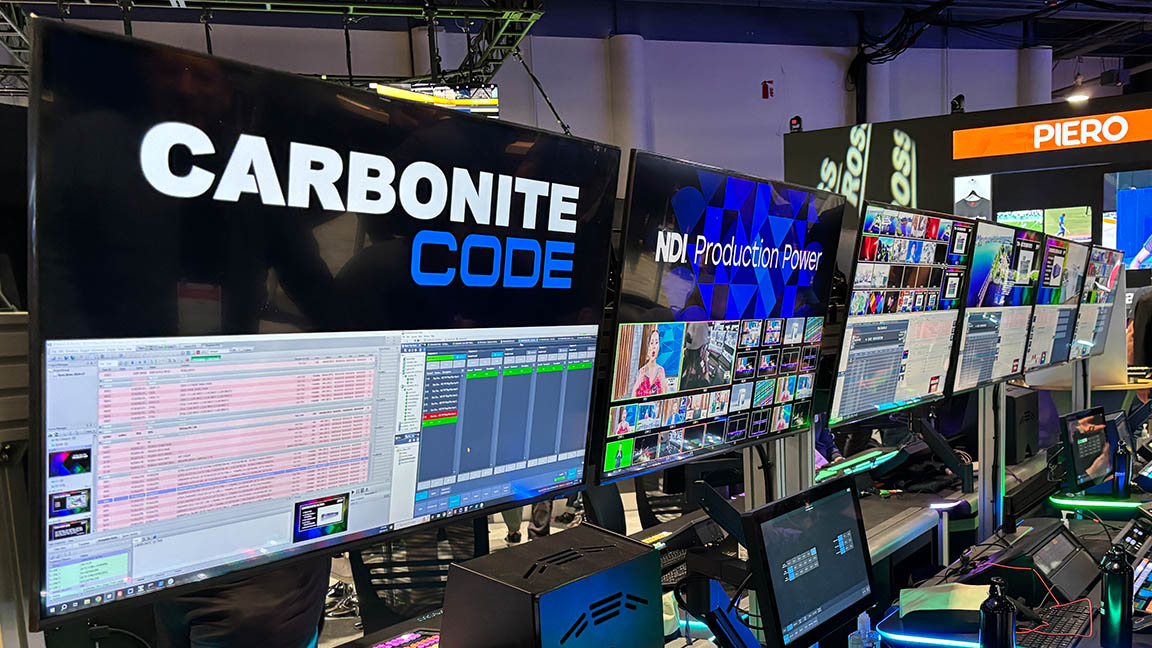NDI: Driving AVoIP Workflows
In an exclusive Q&A, NDI president Daniel Nergård talks selling points, growing markets, and industry challenges.

Technically, it's called Network Device Interface, but we all know it as NDI. Introduced by NewTek in 2015, it's an IP transmission protocol that delivers real-time, broadcast-quality audio and video. These days, following the acquisition of NewTek in 2019, NDI is part of the Vizrt Group.
Over the past decade, NDI has become one of the most dominant video-over-IP solutions for Pro AV applications. And the company has continued to improve the protocol, releasing Version 6 in Spring 2024 and following that with a 6.1 update last December. SCN sat down with Daniel Nergård, NDI president, to learn the secrets to NDI's success as well as the company's plans for continued growth.
SCN: How long have you been president of NDI, and what are your responsibilities?
Daniel Nergård: I have had the privilege to serve as the president of NDI for the past year. In my role, I oversee our global operations, focusing on innovation and expanding our ecosystem. I strongly believe in unlocking NDI’s growth and adoption potential, which includes further driving NDI adoption across various segments and scaling our commercial adoption among enterprises. This ensures we’re supporting industry needs and that we remain at the forefront of shaping future workflows and helping our clients with efficiency.
SCN: What do you consider some of the major selling points of NDI?
DN: The adoption of video-over-IP has become more than a trend. It is now a standard transition for video-based industries. NDI has become the standard solution that provides users with seamless interoperability, low cost, and an unparalleled ecosystem of products that offer both flexibility and professional performance.
NDI’s high-quality, low-latency solutions integrate seamlessly into existing systems. We can support nearly any type of production including live broadcasts, esports, virtual conferences, and many more. Notably, NDI was an integral part of enabling a global hybrid and virtual live event experience that connected 26 countries for MMG Events. With NDI, MMG was able to deploy more than 200 signals across its network, significantly improving scalability and flexibility.
[Cloud Power: Wheels Not Included]
A daily selection of the top stories for AV integrators, resellers and consultants. Sign up below.
Additionally, Chess.com, the world’s leading online chess platform, utilized NDI as the primary signal transport for its fully remote, cloud-based production. Its innovative use enabled highly adaptable and efficient workflow, managing anywhere between 80-120 signals per event.
Further demonstrating NDI’s versatility, Siemens integrated it into its state-of-the-art communication center to streamline corporate broadcasts. Touting NDI’s flexibility, fast setups, and cost efficiency, Siemens made a gradual transition over an 18-month period from SDI to NDI, expanding its video-based services.

SCN: What are the costs associated with NDI?
DN: NDI offers a royalty-free SDK and a suite of free NDI tools, including comprehensive documentation and resources to integrate NDI into their applications. This is available to creators and developers without licensing fees for implementing the standard, enabling widespread adoption and allowing for any product or platform to become seamlessly compatible with the NDI ecosystem.
Additionally, users who seek more advanced features or for commercial purposes, the Advanced SDK is available, providing enhanced features and capabilities. The Advanced SDK requires users to enter into a licensing agreement; associated costs vary based on the scope and specific requirements of their project.
SCN: Is NDI as good as SDI?
DN: NDI has become the standard solution in a wide range of industries. While SDI is a trusted solution for various live production events such as hybrid and remote productions, NDI can be integrated seamlessly into all live events and offers several advantages, especially in modern, IP-based workflows. These include NDI’s support for higher flexibility, scalability, simple infrastructure and lower-cost integration. Additionally, NDI delivers high-quality, low-latency video and audio transmission that can be scaled easily compared to SDI.
SCN: It’s pretty easy to find PTZ cameras compatible with NDI, but what other hardware and software solutions have integrated NDI into their products?
DN: NDI’s widespread adoption goes beyond PTZ cameras. We have built an ecosystem made up of various hardware and software such as video switchers, encoders, decoders, media servers, and displays, all designed to support high-quality content creation across various applications. Further, we’ve expanded our certification program to include network switches from NETGEAR, Yamaha’s SWR and SWX lines of network switches, and Thinlabs' line of PoE live production computers. Our ecosystem and various devices grow as NDI is growing with our end users, which is amazing.
SCN: In an industry filled with AVoIP protocols, why do you think NDI has been embraced by so many manufacturers?
Through seamless interoperability, low cost, and flexible, professional-grade performance, NDI has set the standard for the Pro AV industry.
DN: We pride ourselves on providing high-quality, low-latency solutions that are easy to use and implement. Through seamless interoperability, low cost, and flexible, professional-grade performance, NDI has set the standard for the Pro AV industry. The ability to seamlessly integrate into existing networks and workflows continues to meet the demands of broadcast, live events, corporate environments, and many more. Additionally, our rapidly growing ecosystem ensures that both customers and end users have access to a wide range of compatible tools. We take the time to listen to our partners and industry professionals about their pain points and what they’re looking for in innovations. That feedback is crucial to how we develop and adapt our solutions.
SCN: How important is the metadata component to NDI’s success, and does NDI support KVM?
DN: Metadata is a key component of NDI’s functionality, offering developers an ideal infrastructure that can handle custom and public metadata transmissions. Users are in control of how they leverage metadata connectivity over NDI, as it allows for deeper integration and removing limitations other than bandwidth. Three main components make NDI suitable for metadata.
Flexibility: NDI is equipped to support metadata through an XML-based format. This allows users to include diverse metadata types without strict guidelines.
Bidirectional: Users can access more efficient infrastructures through a single NDI connection that both sends and receives metadata.
Reliability: NDI provides users with a robust connectivity stack with frame-accurate metadata processing.
Since the second half of 2024, we’ve been actively collaborating with ecosystem partners to expand metadata support for key standards with upcoming enhancements including closed captioning, MIDI, and DMX, further extending NDI’s capabilities.
[The Integration Guide to KVM 2025]
As for KVM, NDI already supports this functionality in the Advanced SDK, with comprehensive documentation and guidance available on our website to assist users with implementation.
SCN: Are the education and corporate conference markets growing areas for NDI?
DN: Yes. For instance, we’ve partnered with various universities on a multitude of projects including Butler University’s Esports Park and the University of the Arts London and Cranfield University, both of which used NDI to optimize hybrid and remote learning. Every day we learn about more cases on how NDI is used in the education environment.
In the corporate conferencing space, NDI technology has been leveraged to streamline corporate broadcasts for global companies including Siemens. Prior to using NDI, Siemens used an all-SDI baseband architecture for its studio—but thanks to the transition to NDI, the team at Siemens have cut the costs by half and event setup time by a third compared to SDI.
SCN: How does NDI fit into an esports workflow?
DN: NDI’s ability to provide high-quality, low-latency video and across large-scale live productions makes it an ideal suitor for esports workflows. Additionally, NDI simplifies the integration process of multiple cameras, streaming setups, graphic systems, and more, into a single unified production. For instance, as previously mentioned, Chess.com integrated NDI into its fully remote, cloud-based studio broadcasts to seamlessly manage multiple transport signals and camera inputs from various camera types, enabling efficient and scalable production for 300 chess matches each year.

SCN: What are the greatest challenges facing NDI?
DN: We’re continuing to see an increased demand for IP-based video solutions. Within that lies an opportunity for NDI to continue its rapid adoption rate and expanded user base. With this demand comes a plethora of needs from segments and users, each requiring more features and personalized solutions to fit their specific needs. We need to prioritize and recognize how to create a roadmap encompassing the entire community as much as possible. We are constantly working to address individual feedback and invest in innovation that benefits all. The recent launch of our Connected Community Platform is giving us yet another opportunity to be close to our end users, educate them on the use of NDI, and listen to their feedback.

Mark J. Pescatore, Ph.D., has been the content director of Systems Contractor News since 2021. During his career, he's hosted and programmed two ongoing regional industry trade shows (including Future B2B's AV/IT Summit), produced and hosted podcasts and webinars focused on the professional video marketplace, taught more than a dozen college communication courses, co-authored the book Working with HDV, and co-edited two editions of The Guide to Digital Television.
